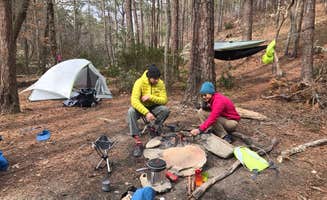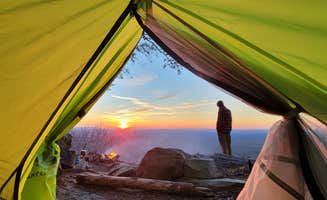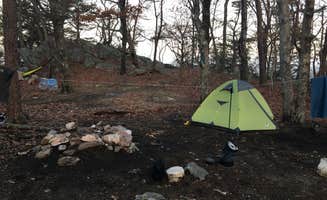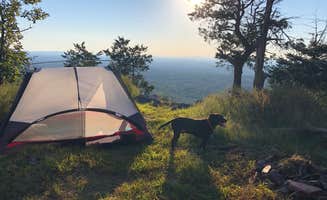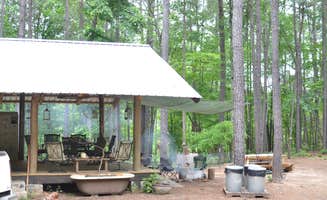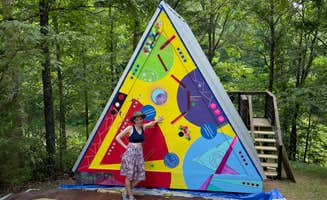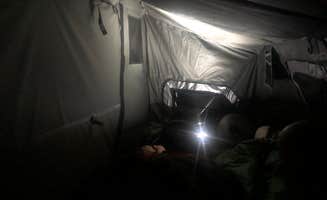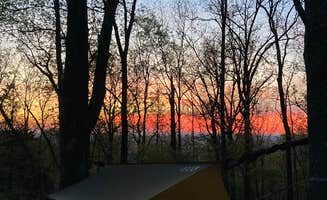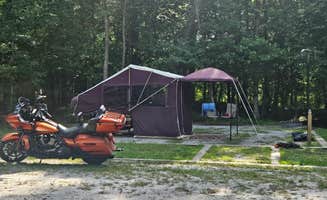Tent camping in Talladega National Forest ranges from 1,000 to over 2,600 feet in elevation, offering varied terrain and forest cover. Most primitive sites require a short hike, typically 0.5 to 2 miles from trailheads, and feature established fire rings but minimal other amenities. The best camping season runs from mid-March through October when temperatures range from 45°F at night to 85°F during peak summer days.
What to do
Hike to plane wreckage sites: Several hiking trails near McDill Point Backcountry pass by an aircraft crash site. "Just past McDill, there is a side trail that takes you to debris from a 1972 plane crash site," notes camper Nancy C. The wreckage serves as an unofficial landmark for hikers heading toward the point.
Visit Cheaha Lake: Located within a short drive of most campgrounds, this small lake provides swimming and fishing opportunities during summer months. One visitor at Cheaha Falls Campground mentioned, "We enjoyed the playground and the lake with the kids. This is a place we will be back for sure."
Explore CCC historical structures: The Civilian Conservation Corps built several structures in the area during the 1930s. A camper observed, "There is a camp store onsite along with various museums and buildings built by the CCC. The staff hosted several educational activities and were extremely helpful and informative."
What campers like
Privacy between sites: Campers consistently mention the spacing between sites at Turnipseed Campground as a major advantage. "Each site is spaced a good distance from the other," notes Peg W. Another camper adds, "Even when the campground is full you will not be on top of other campers."
Rock formations for shelter: Natural rock features throughout the backcountry provide wind protection and make for excellent hammock camping spots. One camper at Pinhoti Trail Backcountry mentioned, "The most stunning vistas await you right after completing the climb up from Clairmont Gap. These panoramas make the somewhat challenging trek worthwhile."
Wildlife viewing opportunities: Early mornings offer the best chances to spot wildlife. A visitor noted, "We saw and heard a lot of birds and wildlife here! Explore as many trails as you can, especially the Pinhoti trail. There is a ton of diversity in this area, including lovely plants, geology, animals, and deep almost completely undisturbed wilderness."
What you should know
Water sources unreliable: Many backcountry sites require carrying all water. A hiker at Pinhoti Campsite warns, "Be sure to bring an ample supply of water for this section of the trail, as there are no reliable water sources nearby for refilling."
No reservations available: Most tent sites operate on first-come, first-served basis. "It's very nice to just drop five dollars in a box and go camp there are no attendants here," explains one Turnipseed camper.
Limited cell reception: Prepare for disconnection in most camping areas. One camper at Pinhoti and Skyway Loop Intersection Campground mentioned, "No cell reception at lower campground (and spotty in general, but in all honesty this is more a PRO unless you have work or other obligations)."
Hunting seasons affect camping: During fall and winter hunting seasons (October-January), some areas have increased hunter presence. "As the name implies, it is used heavily by hunters," warns a camper about certain areas.
Tips for camping with families
Start with shorter loops: For families with younger children, begin with trails under 3 miles. A parent shared, "The short hike to the gorgeous falls is perfect for the kids. While you can continue on for miles if you wish, we prefer to stay at the water and climb the little falls."
Consider nearby amenities: Some tent sites offer better access to facilities. A visitor to Cheaha Falls Private Backcountry Campsite noted, "The site we stayed at is in the area of Cheaha falls but is behind a couple of other campsites in its own secluded area. You just follow the river upstream to get there."
Plan waterfall visits: Schedule waterfall hikes when water levels are highest. "In springtime everything is magical when the plants are blooming and all the wildlife is out and exploring. Also, make sure to continue along the trail for a couple more miles to see the larger falls," recommends a camper.
Tips from RVers
Small RVs only: Most camping areas have limited access for larger vehicles. At Bohamia, visitors found better options: "Services are great some cabins and tents having ACs, but primitive camping allowed as well. Great showers and bathhouse with filtered drinking water option that I used daily."
Best RV alternatives: When tent camping isn't ideal, look for alternative accommodations. A camper advised, "I would not go here in an RV," about Turnipseed, while another mentioned, "This is a cute car camping site that we have stayed at several times. It was actually closed for COVID when we were there but I believe that it is now reopened."



